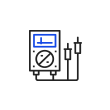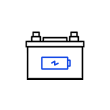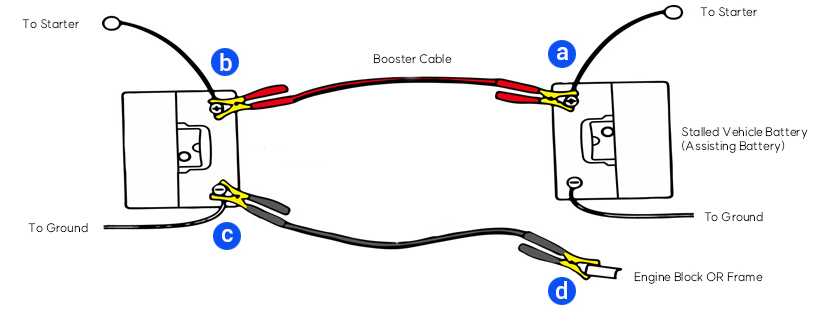TECHNOLOGY
We introduce DN Automotive’s technology shown in the best batteries.
-
TECHNOLOGY
-
Directions for Battery Maintenance

-
Battery charging and Jump start method

Battery charging and Jump start method
We have collected our know-hows for optimal DN Automotive battery maintenance.
Charging Methods
Check the State of Charge
-

Check the indicator to see if the battery is okay, needs to be charged or requires replacement. A voltmeter is preferable for exact check.
-

If the indicator shows black color, it is necessary to be recharged. And in a general case, it is necessary to be recharged if voltage is under 12.4V.
Constant Current Charging
Calculation of auxiliary charging amount
-

Charging amount
C = C20 * D * 1.2
- ⓐ C : Charging amount (Ah)
- ⓑ C20 : 20Hr rate capacity
- ⓒ 1.2 : 120 % (coefficient)
- ⓓ D : Discharging amount(%)
-

Charging time
T = C / A
- ⓐ T : Charging time (Hr)
- ⓑ C : Charging amount (Ah)
- ⓒ A : Charging current (A)
-

Calculation example
MF80D26L(70Ah / 20Hr) Open circuit voltage 12.40V How to charge?
- ⓐ Charging amount : 70Ah * 0.25 * 1.2 = 21.0Ah
(25% discharged; see TABLE 1) - ⓑ Charging current : C20 * 0.05 = 3.5A (see TABLE 2)
- ⓒ Charging time : 21.0Ah / 3.5A = 6.0Hr
- ⓐ Charging amount : 70Ah * 0.25 * 1.2 = 21.0Ah
-
TABLE 1. State of Charge
OCV [V] MARINE No. 12.75 100% 12.4 75% 12.2 50% 12.0 25% 11.9 Discharged -
TABLE 2. Charging Current according to state of charge by battery capacity.
 Scroll left and right to see the full contents.
Scroll left and right to see the full contents.
State OCV [V] ~ 40Ah
2.0A50Ah ~
2.5A~ 60Ah
3.0A~ 70Ah
3.5A~ 80Ah
4.0A~ 90Ah
4.5A~ 100Ah
5.0A100% 12.75 75% 12.4 6Hrs 50% 12.2 12Hrs 25% 12.0 18Hrs Discharged 11.9 24Hrs
Constant Voltage Charging
To calculate a constant voltage charge
- Voltage :
- 14.4 ~ 16.0V
- Current :
- Under 10A
- Charging Time :
- Over 12Hr (General battery)
- End the charge :
-
The following points will tell you if a battery has been properly charged :
1) Indicator is green and current is below 1.0A during charge.
2) Open circuit voltage is stabilized at or above 12.7V.
Safety Precautions
-
01Connect positive (+) charger cable to positive (+) terminal of battery.and negative (-) charger cable to negative (-) terminal
-
02Always charge batteries in a well-ventilated area.
-
03If violent gassing or spewing of electrolyte occurs, temporarily reduce or halt charging. (Possible battery failure)
-
04If violent gassing or spewing of electrolyte occurs, temporarily reduce or halt charging. (Possible battery failure)
Jump Starting
Safety Rules
-
01Before proceeding, read safety precautions in Section 1.
-
02Warning - Batteries produce explosive gases.
These instructions are designed to minimize the explosion hazard while jump-starting a car. Keep sparks, flames and cigarettes away from batteries at all times. -
03Shield eyes and face at all times. Never lean over the battery when jump starting.
-
04Inspect both batteries before connecting booster cables and do not jump start a damaged battery.
-
05Make sure the vehicles are not in contact with each other.
-
06Turn off all electrical equipment (radio, defroster, windshield wipers, lights, etc.).
The Following Steps Should be Proceeded:

-
aConnect positive (+) booster cable to positive (+) terminal of discharged battery.
-
bConnect other end of positive (+) cable to positive (+) terminal of assisting battery.
-
cConnect negative (-) cable to negative (-) terminal of assisting battery.
-
dMake final connection of negative (-) cable to engine block of stalled vehicle,away from battery and carburetor.
-
eMake sure that cables are away from fan blades, belts and other moving parts of both engines.
-
fStart vehicle and remove cables in reverse order of connections.
